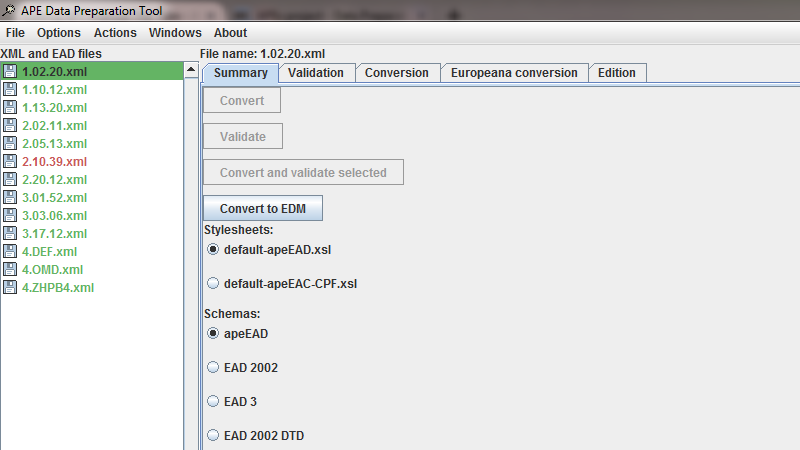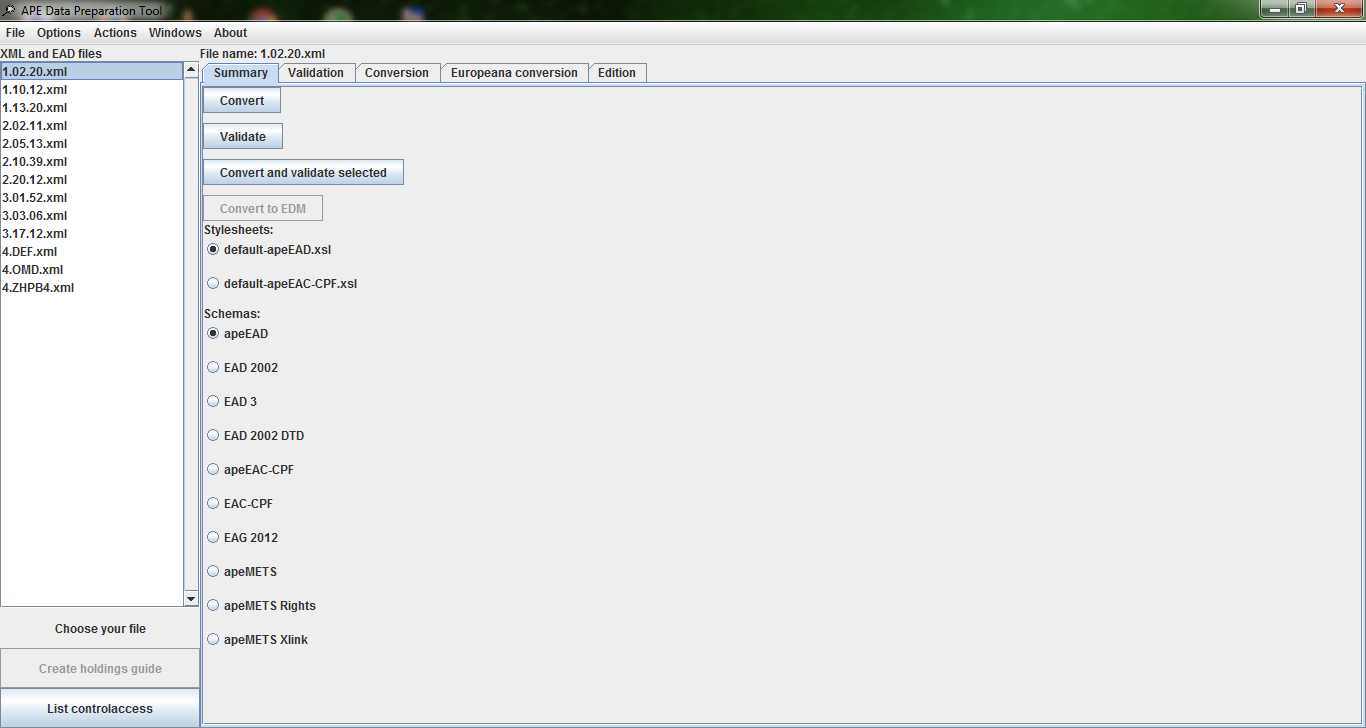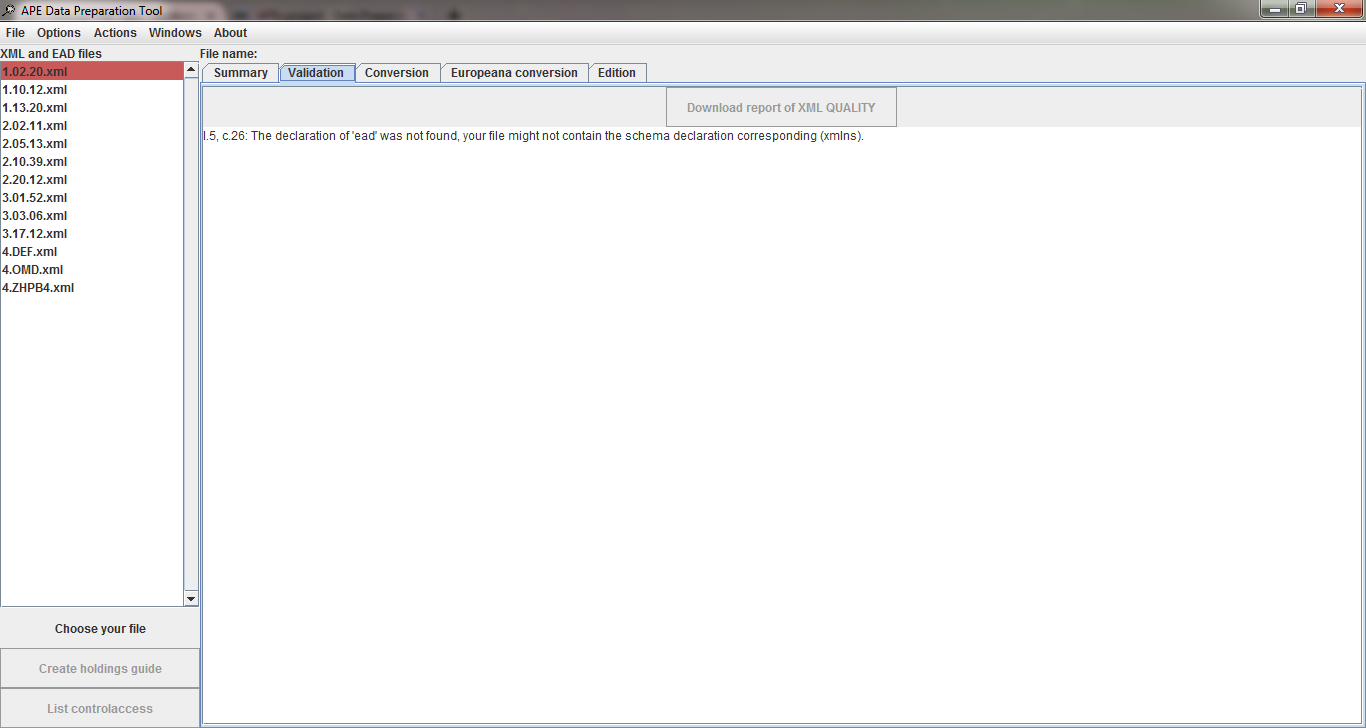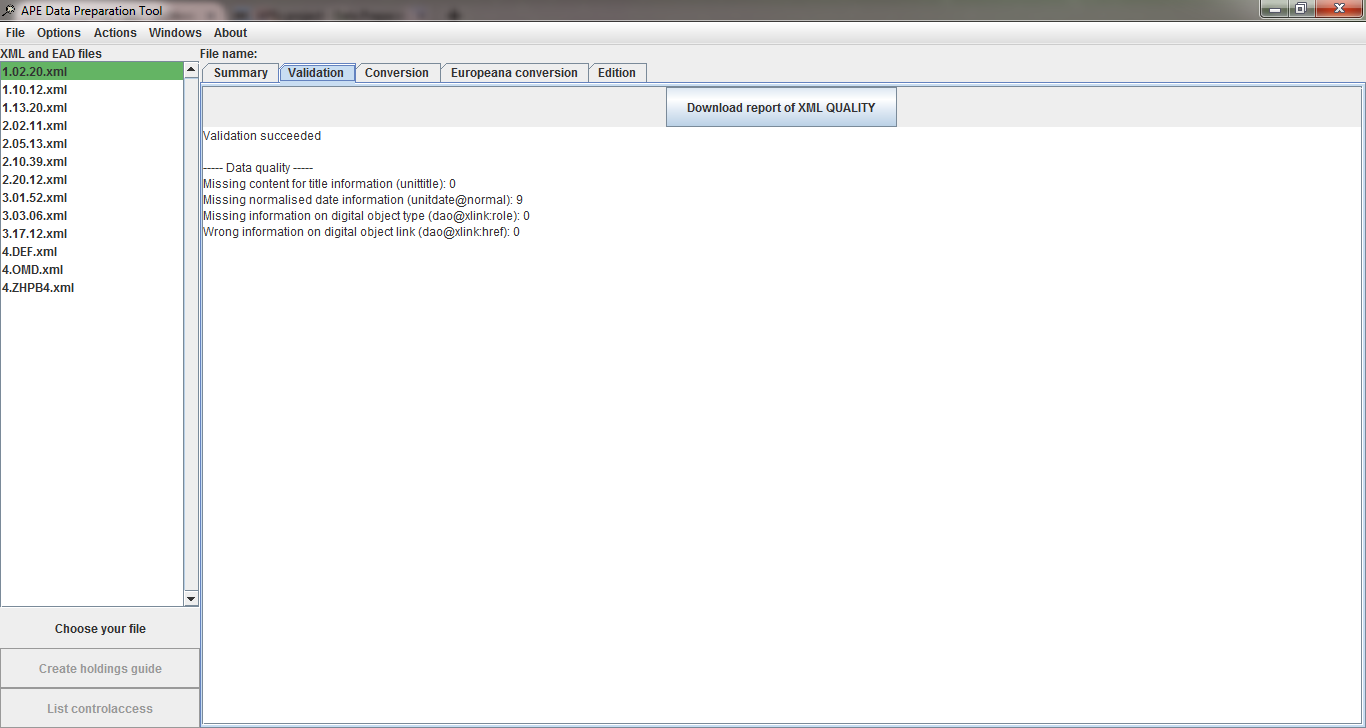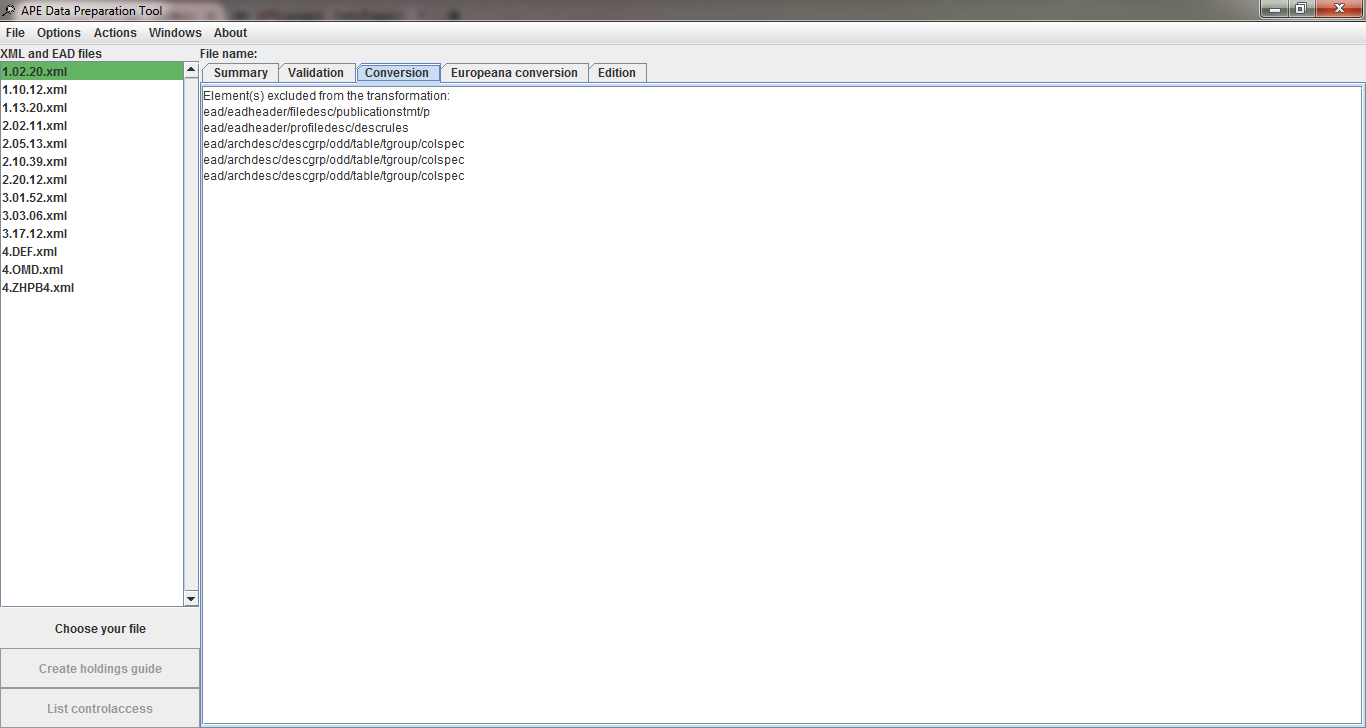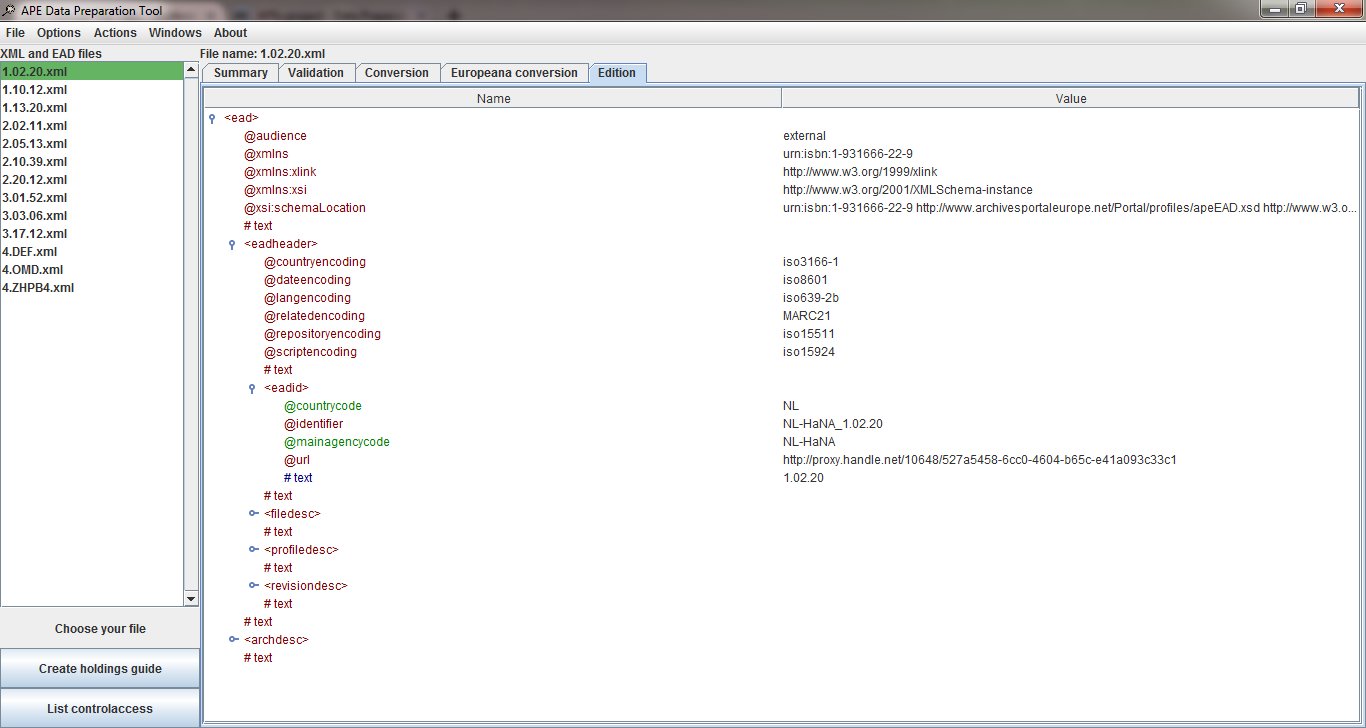Difference between revisions of "DPT manual The Tabs"
(→Europeana conversion tab) |
|||
| Line 4: | Line 4: | ||
<br clear=all> | <br clear=all> | ||
<div><br/>__TOC__<br/></div> | <div><br/>__TOC__<br/></div> | ||
| − | == Summary tab == | + | == the Summary tab == |
The first and main tab is the '''''Summary''''' tab. It's opened by default when you start the tool. This is where you can apply operations to your XML files. When a file is selected in the list, you can, from this tab, convert the file to the Archives Portal Europe format, pass it to the validator or convert it to the Europeana format. You have the possibility to choose the style sheet to be used for the conversion, even - [[DPT_manual_The_Menus#Use_own_stylesheet|when you have uploaded one]] - your own style sheet. The same goes for the schemas. Please note that the action buttons and radio buttons are available only if the action is possible for the selected file. | The first and main tab is the '''''Summary''''' tab. It's opened by default when you start the tool. This is where you can apply operations to your XML files. When a file is selected in the list, you can, from this tab, convert the file to the Archives Portal Europe format, pass it to the validator or convert it to the Europeana format. You have the possibility to choose the style sheet to be used for the conversion, even - [[DPT_manual_The_Menus#Use_own_stylesheet|when you have uploaded one]] - your own style sheet. The same goes for the schemas. Please note that the action buttons and radio buttons are available only if the action is possible for the selected file. | ||
| Line 11: | Line 11: | ||
<br clear=all> | <br clear=all> | ||
| − | == Validation tab == | + | == the Validation tab == |
The second tab is the '''''Validation''''' tab. In this tab you will find the results of a validation for the selected file. It can either contain a sentence saying the validation succeeded, show an error message, or a list of all the errors found during the validation process, with the indication of the lines and columns where the errors have been found. You can find in [[DPT_manual_Annexes#Annex_1:_Validation_errors.2C_meaning_and_possible_fixes|Annex 1]] a list of the possible errors, their meaning and the actions to be taken to avoid them. | The second tab is the '''''Validation''''' tab. In this tab you will find the results of a validation for the selected file. It can either contain a sentence saying the validation succeeded, show an error message, or a list of all the errors found during the validation process, with the indication of the lines and columns where the errors have been found. You can find in [[DPT_manual_Annexes#Annex_1:_Validation_errors.2C_meaning_and_possible_fixes|Annex 1]] a list of the possible errors, their meaning and the actions to be taken to avoid them. | ||
| Line 32: | Line 32: | ||
This information also can be downloaded via the button '''''Download report of XML QUALITY''''' in the tab: it is saved in the report file which can be found in the output folder of the tool. To save this information for several files, you have to use the same command from the File menu. You can improve the data quality of your files by editing them or by adding rules for date conversion and by indicating the digital object type. | This information also can be downloaded via the button '''''Download report of XML QUALITY''''' in the tab: it is saved in the report file which can be found in the output folder of the tool. To save this information for several files, you have to use the same command from the File menu. You can improve the data quality of your files by editing them or by adding rules for date conversion and by indicating the digital object type. | ||
| − | == Conversion tab == | + | == the Conversion tab == |
The third tab is the '''''Conversion''''' tab and this will display information on the transformation performed on the files and the problems encountered: | The third tab is the '''''Conversion''''' tab and this will display information on the transformation performed on the files and the problems encountered: | ||
| Line 44: | Line 44: | ||
''Note that the conversion tab does not list all changes made to the file, but only the elements discarded during the conversion.'' | ''Note that the conversion tab does not list all changes made to the file, but only the elements discarded during the conversion.'' | ||
| − | == Europeana conversion tab == | + | == the Europeana conversion tab == |
The fourth tab is the '''''Europeana conversion''''' tab and this displays information on the EDM conversion. Files that are transformed into EDM format are automatically saved in the output folder (or an alternatively chosen default folder for saved files, if you have chosen to do so). Their names stay the same with an additional "-edm" before the file extension. For more information regarding the conversion to EDM, please see [[DPT_manual_Additional_functionalities#EDM_conversion|EDM conversion part]] of this manual. | The fourth tab is the '''''Europeana conversion''''' tab and this displays information on the EDM conversion. Files that are transformed into EDM format are automatically saved in the output folder (or an alternatively chosen default folder for saved files, if you have chosen to do so). Their names stay the same with an additional "-edm" before the file extension. For more information regarding the conversion to EDM, please see [[DPT_manual_Additional_functionalities#EDM_conversion|EDM conversion part]] of this manual. | ||
| − | == Edition tab == | + | == the Edition tab == |
The last tab is the '''''Edition''''' tab. When a finding aid is selected in the list, it is read and displayed in a tree like view showing it in the EAD/XML version. Only some EAD/XML elements can be edited in the tool, they are marked in green or blue: | The last tab is the '''''Edition''''' tab. When a finding aid is selected in the list, it is read and displayed in a tree like view showing it in the EAD/XML version. Only some EAD/XML elements can be edited in the tool, they are marked in green or blue: | ||
Revision as of 07:25, 3 August 2018
The right part of the screen contains five tabs: Summary, Validation, Conversion, Europeana conversion and Edition.
the Summary tab
The first and main tab is the Summary tab. It's opened by default when you start the tool. This is where you can apply operations to your XML files. When a file is selected in the list, you can, from this tab, convert the file to the Archives Portal Europe format, pass it to the validator or convert it to the Europeana format. You have the possibility to choose the style sheet to be used for the conversion, even - when you have uploaded one - your own style sheet. The same goes for the schemas. Please note that the action buttons and radio buttons are available only if the action is possible for the selected file.
the Validation tab
The second tab is the Validation tab. In this tab you will find the results of a validation for the selected file. It can either contain a sentence saying the validation succeeded, show an error message, or a list of all the errors found during the validation process, with the indication of the lines and columns where the errors have been found. You can find in Annex 1 a list of the possible errors, their meaning and the actions to be taken to avoid them.
Please note that if you validate a file before the conversion, the lines indicated in the error report will be the ones of your original file, but if you validate a file after the conversion, the lines indicated will be the ones of the new converted file, therefore will not exactly correspond to your original file. In that case it's best to save the file to the output folder for evaluating the error message.
In case of a successful validation of a finding aid, a report on the data quality or completeness of the file will be displayed, indicating the number of missing or wrong information for four EAD elements:
- Missing content for title information (unittitle)
- Missing normalised date information (unitdate@normal)
- Missing information on digital object type (dao@xlink:role)
- Wrong information on digital object link (dao@xlink:href)
This information also can be downloaded via the button Download report of XML QUALITY in the tab: it is saved in the report file which can be found in the output folder of the tool. To save this information for several files, you have to use the same command from the File menu. You can improve the data quality of your files by editing them or by adding rules for date conversion and by indicating the digital object type.
the Conversion tab
The third tab is the Conversion tab and this will display information on the transformation performed on the files and the problems encountered:
- For finding aids the tab lists the elements (and their attributes, if applicable) that are being excluded either because they are not recognised, either because they do not comply to the apeEAD profile which is more restrictive than the EAD 2002.
- The tabs also indicate the problems due to the c-element hierarchy, when a c-level is not understood.
Note that the conversion tab does not list all changes made to the file, but only the elements discarded during the conversion.
the Europeana conversion tab
The fourth tab is the Europeana conversion tab and this displays information on the EDM conversion. Files that are transformed into EDM format are automatically saved in the output folder (or an alternatively chosen default folder for saved files, if you have chosen to do so). Their names stay the same with an additional "-edm" before the file extension. For more information regarding the conversion to EDM, please see EDM conversion part of this manual.
the Edition tab
The last tab is the Edition tab. When a finding aid is selected in the list, it is read and displayed in a tree like view showing it in the EAD/XML version. Only some EAD/XML elements can be edited in the tool, they are marked in green or blue:
- eadid @mainagencycode
- eadid @countrycode
- eadid / text
- langusage / language
- langusage / language / text
- langmaterial / language
- langmaterial / language / text
- unitdate@normal
- titleproper / text
- c @level
The <eadid/> element is mandatory to validate your file. The elements and attributes related to the language are useful for the display and refinement of the search results. The same goes for the date: a date is searchable only if normalised. An empty titleproper will be displayed as "no title".
